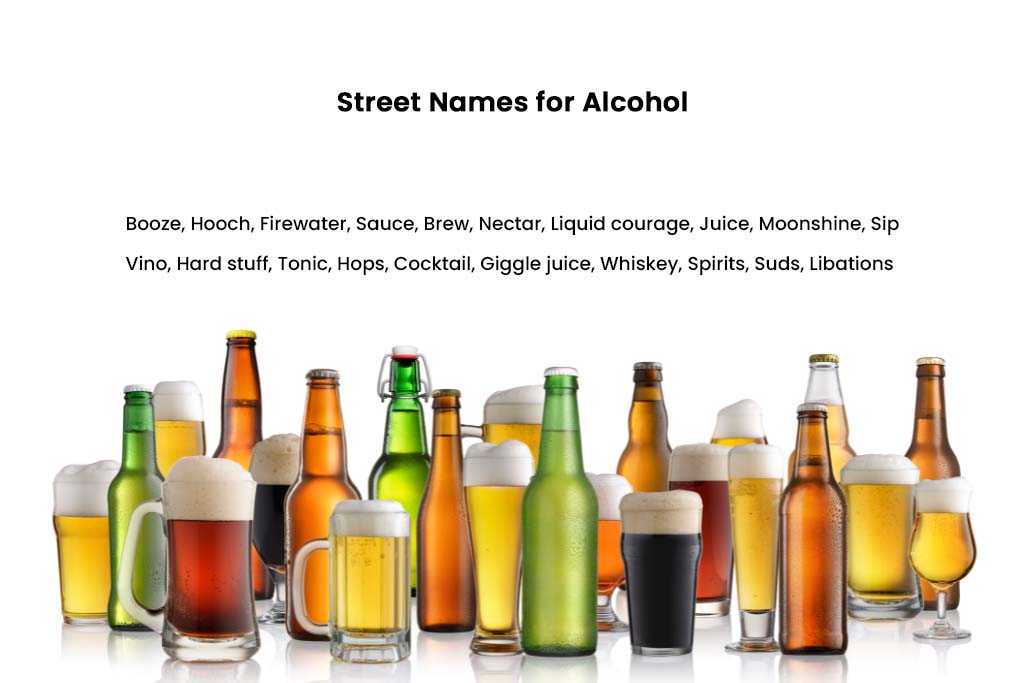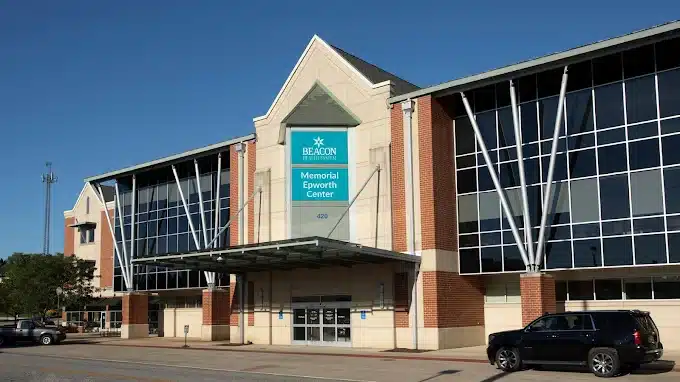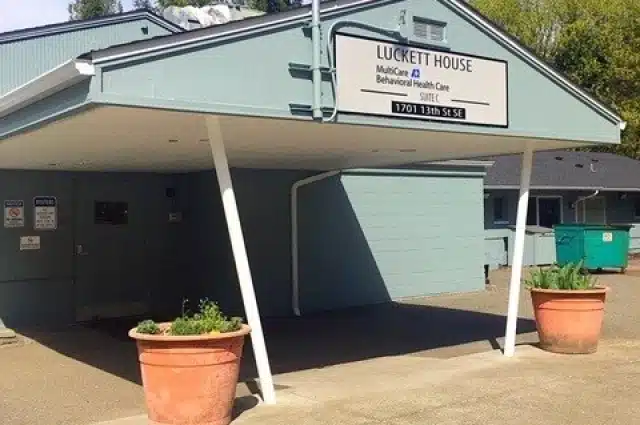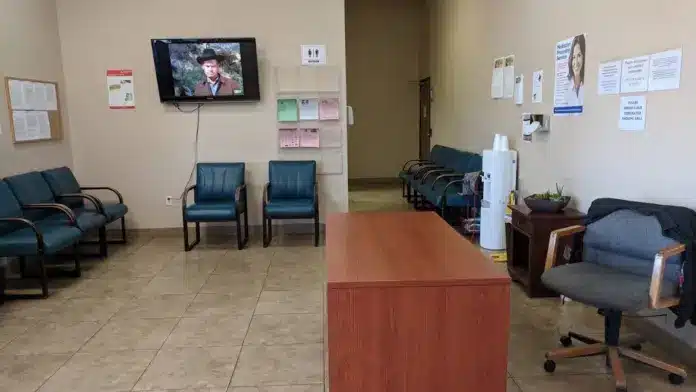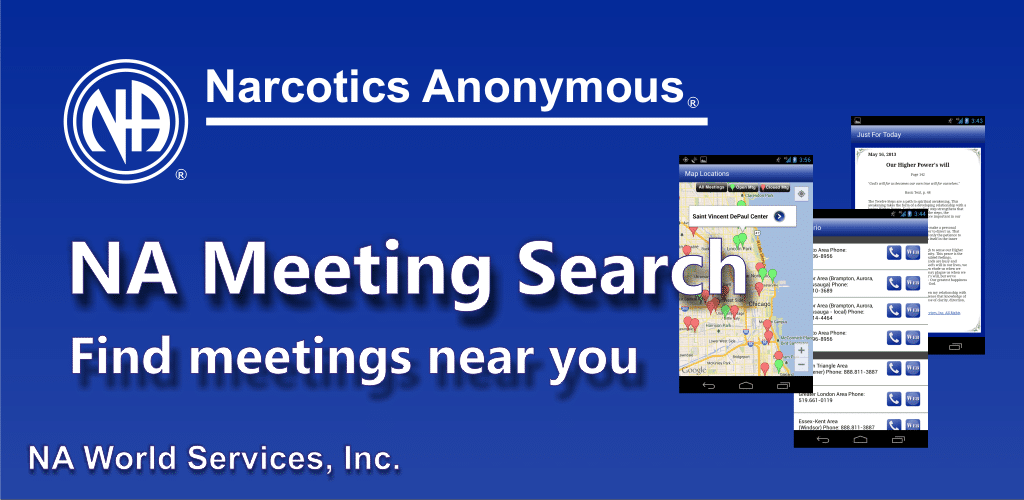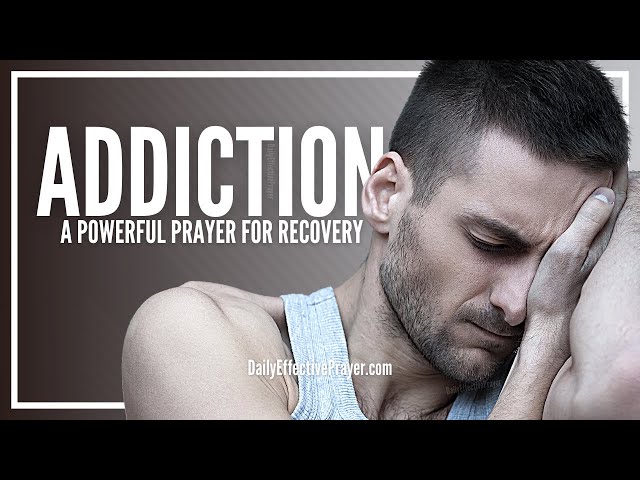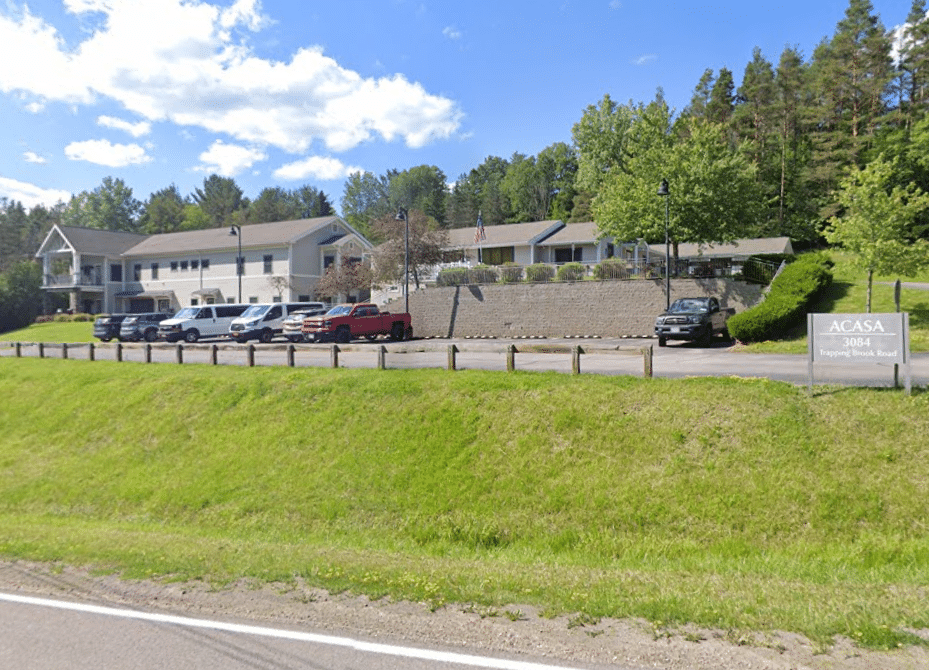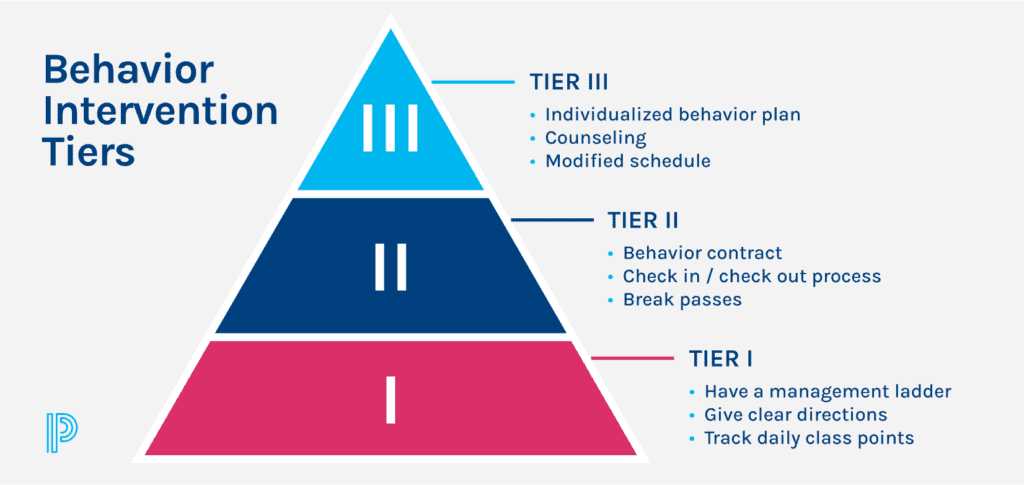
Understanding Intensive Intervention for Students and Individuals with Significant Needs
Tier 3 intervention is the most intensive support within a Multi-Tiered System of Supports (MTSS) or Response to Intervention (RTI) framework. It’s designed for individuals who need highly individualized strategies to address severe and persistent academic, behavioral, or social-emotional challenges after universal (Tier 1) and targeted (Tier 2) supports have proven insufficient.
Key facts about Tier 3 intervention:
- Who it serves: The 1-5% of individuals with the most significant needs.
- Intensity: Typically 120-135 minutes per week of direct support.
- Frequency: Delivered daily with at least weekly progress monitoring.
- Group size: One-on-one or in very small groups (1-3 individuals).
- Approach: Highly individualized and based on comprehensive, data-driven assessment.
This level of intervention is not limited to special education; any individual demonstrating a need for intensive support can receive Tier 3 services. The process involves specialized assessment, individualized planning, and frequent monitoring to ensure progress.
At Addiction Helpline America, we recognize that these principles of intensive, individualized support are also life-changing in mental health and substance use treatment. Our team guides individuals and families in finding appropriate levels of care, from assessment to intensive treatment, mirroring the personalized, data-driven approach of tier 3 intervention.
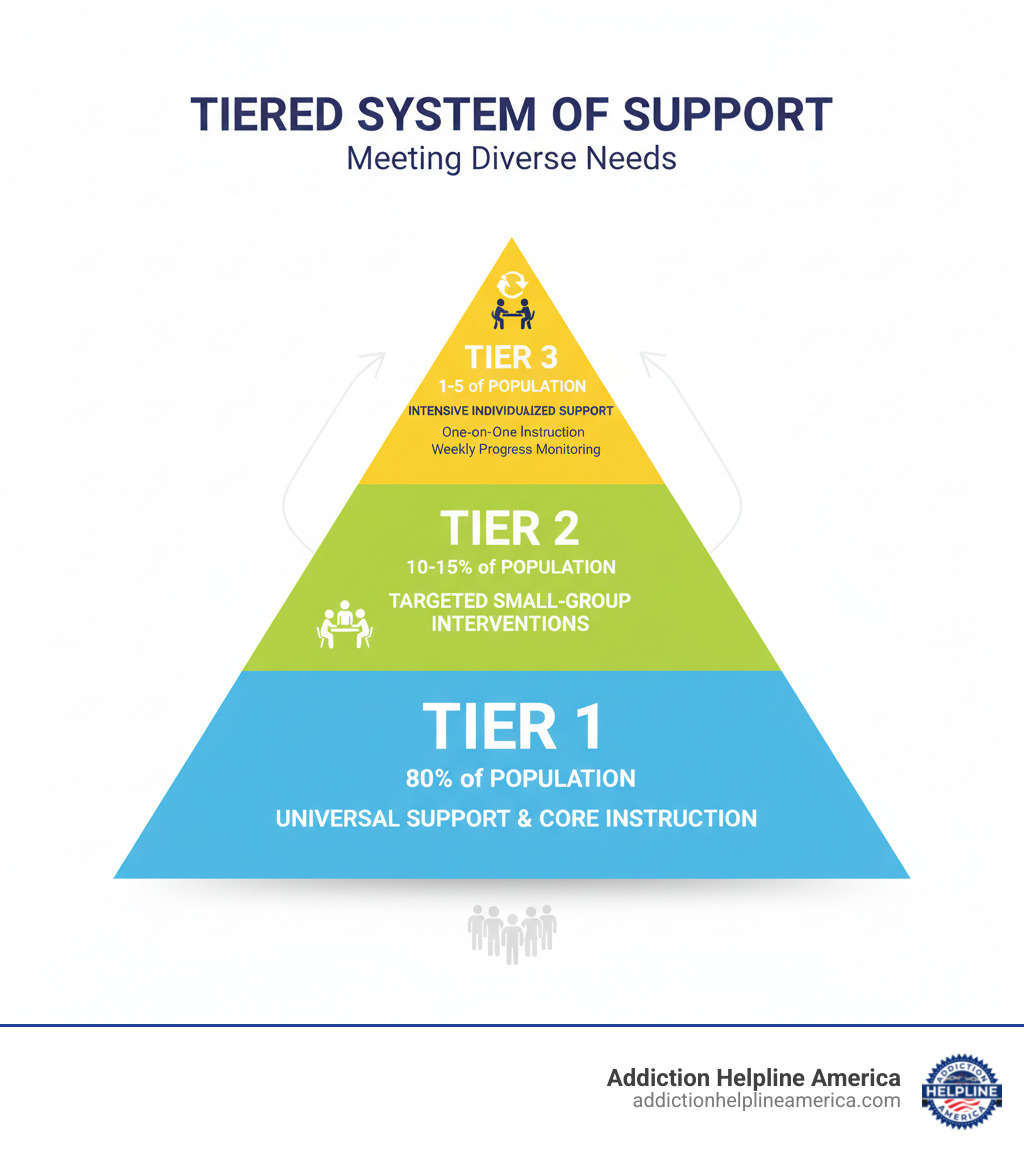
Tier 3 intervention terms to know:
Understanding the Tiered Intervention Framework
To understand tier 3 intervention, it helps to see it as the top of a support pyramid. This structure, known as a Multi-Tiered System of Supports (MTSS), Response to Intervention (RTI), or Positive Behavior Interventions and Supports (PBIS), is a proactive framework for helping every student succeed. Instead of waiting for failure, it uses data to catch struggles early and match support to individual needs. This three-level prevention model, borrowed from public health, ensures no one falls through the cracks. For more details on this framework, visit The Center on Multi-Tiered System of Supports.
What is Tier 1 and Tier 2 Support?
Before reaching Tier 3, students receive support at two foundational levels.
Tier 1 is universal support for all students (about 80% of the population). It consists of high-quality, evidence-based core instruction and a positive classroom environment. Universal screening helps identify potential issues early.
Tier 2 offers targeted support for the 10-15% of students who need extra help in specific areas. Identified through screening, these students receive small-group interventions (3-6 students) for 20-40 minutes, 3-4 times per week. This is supplemental instruction, and progress is monitored to ensure it’s effective.
Defining Tier 3 Intervention
At the top of the pyramid is tier 3 intervention, the most intensive level of support. It is reserved for the 1-5% of students with severe and persistent challenges—such as chronic learning problems or significant behavioral difficulties—that did not improve with Tier 1 and Tier 2 support.
Tier 3 is not just “more” of Tier 2; it’s a fundamentally different approach. Key features include:
- Highly individualized support, often delivered one-on-one or in groups of 1-3 students.
- Increased intensity, typically 120-135 minutes per week of focused support.
- Personalized plans based on comprehensive diagnostic assessments to identify the root cause of a student’s struggles.
In some cases, Tier 3 may involve a “replacement core program,” substituting the standard curriculum with a more specialized one. The goal is to provide precise, powerful support to help students overcome significant barriers.
At Addiction Helpline America, we apply this same principle to addiction and mental health. Individuals with severe challenges, like co-occurring disorders, need more than general advice. They require an intensive, individualized plan with wraparound services and frequent check-ins, mirroring the tier 3 intervention model.
Core Components of an Effective Tier 3 Intervention
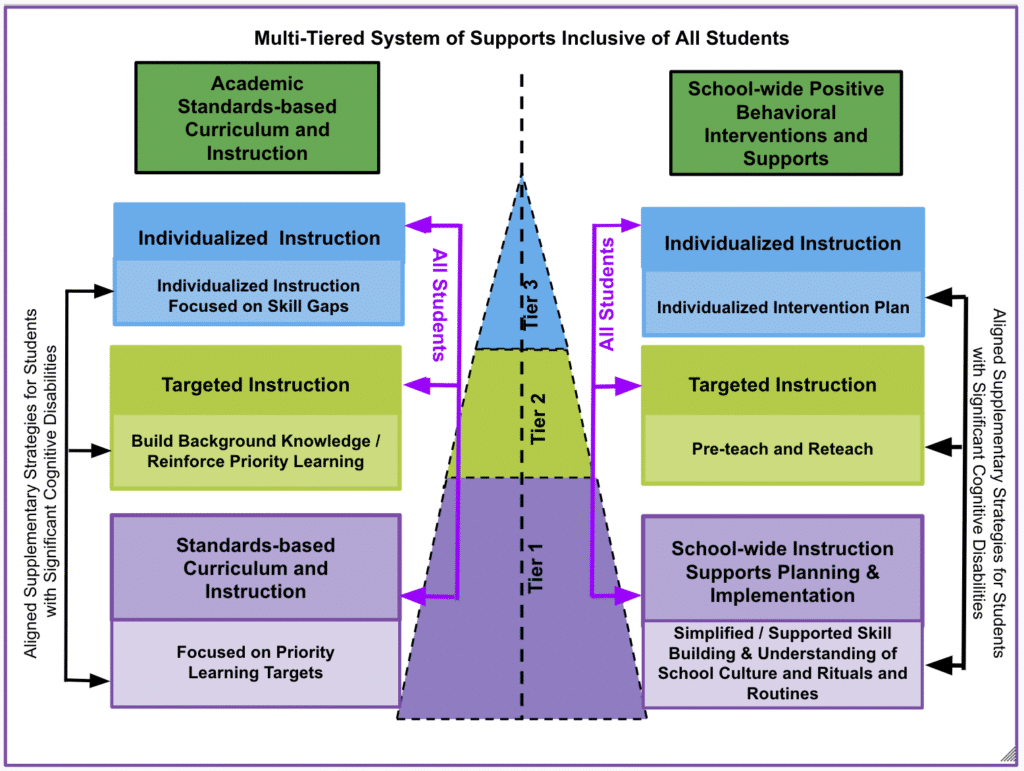
Effective tier 3 intervention is not just about increasing support; it’s about providing a different kind of support, guided by specific systems, practices, and data.
Key Differentiating Characteristics
What truly sets tier 3 intervention apart from Tier 2? The differences in intensity, frequency, and individualization are significant.
| Feature | Tier 2 Intervention | Tier 3 Intervention |
|---|---|---|
| Intensity | Targeted, supplementary support | Highly intensive, individualized, and potentially a “replacement core” |
| Frequency | 3-4 times per week | Typically 5 days a week |
| Duration (Session) | 20-40 minutes | 30-60 minutes, potentially longer, often 120-135 minutes per week of direct support |
| Group Size | Small groups (3-6 students) | Very small groups (1-3 students) or one-on-one instruction |
| Individualization | Addresses common skill deficits within a group | Deeply personalized, based on comprehensive, diagnostic assessment of individual needs |
| Progress Monitoring | Bi-weekly | At least weekly, often more frequent, using specific and sensitive measures |
| Staffing | Teacher or interventionist | Often requires additional specialized staff, multidisciplinary team |
| Focus | Skill deficits, closing gaps | Severe and persistent academic, behavioral, or social-emotional challenges, complex needs that haven’t responded to lower tiers |
The jump to Tier 3 involves daily contact, longer sessions, and plans built from the ground up for one individual, addressing their unique challenges with precision.
Foundational Systems and Core Practices
Effective Tier 3 support relies on a strong infrastructure.
- Multi-disciplinary Team: No single person has all the answers. Tier 3 teams include administrators, teachers, behavior specialists, and family members to create a complete picture of the student’s needs.
- Behavior Support Expertise: For behavioral challenges, a Functional Behavior Assessment (FBA) is used to understand the why behind a behavior. This leads to a Behavior Intervention Plan that teaches positive replacement skills.
- Wraparound and Person-Centered Support: This approach recognizes that a student is part of a family and community. The wraparound process is a family-driven, team-based model that coordinates services and builds on the individual’s strengths and goals, ensuring the plan is culturally and contextually appropriate.
The Role of Data and Progress Monitoring
Data is the compass for tier 3 intervention. The Data-Based Individualization (DBI) process is a systematic method for intensifying and individualizing support based on data. This requires:
- Frequent Progress Monitoring: Data is collected at least weekly to track performance and rate of growth. If progress stalls, the team can adjust immediately.
- Fidelity of Implementation: The team must also monitor whether the intervention is being delivered as intended.
- Diagnostic Assessment: When a student isn’t responding, the team digs deeper to diagnose the issue. Is it a skill deficit (“can’t do”), a performance issue (“trouble doing”), or a motivation problem (“isn’t doing”)? This diagnosis guides adaptations. You can learn more about intensive intervention and the DBI process.
Relationship to Special Education and IEPs
A common point of confusion is the link between Tier 3 and special education. Here’s what to know:
- Tier 3 is not special education. Any student needing intensive support can receive it, regardless of whether they have an Individualized Education Program (IEP).
- It can lead to an evaluation. If a student doesn’t respond to high-quality tier 3 intervention, it may signal a potential disability, triggering a formal evaluation under IDEA 2004.
- Data is valuable. The information gathered during Tier 3 is crucial for the evaluation and for developing an effective IEP if the student is found eligible for special education services.
For more on comprehensive, individualized support, see this guide to Inpatient Behavioral Health.
Practical Application: Teams, Examples, and Challenges

Implementing tier 3 intervention requires a coordinated team, clear examples of what it looks like in practice, and an awareness of potential challenges.
Structuring the Tier 3 Support Team
Effective Tier 3 support relies on two key teams:
- The Tier 3 Leadership Team: This system-level team ensures the school or district has the procedures, resources, and professional development in place for interventions to succeed. They monitor overall implementation and effectiveness.
- The Individual Student Support Team: This team forms for a specific student entering Tier 3. It includes teachers, specialists, and parents who design, implement, and refine the student’s unique intervention plan. Strong communication and collaboration are essential.
The goal is to provide support so effective that the student can eventually transition to less intensive tiers.
Examples of a Tier 3 Intervention
Because it’s highly individualized, tier 3 intervention looks different for every student. Here are some examples:
- Academics: A second-grader reading far below grade level receives daily one-on-one sessions with a reading specialist focused on explicit phonics and fluency practice. A middle schooler struggling with algebra gets daily, pre-teaching of concepts in a very small group using hands-on materials.
- Behavior: An elementary student with aggressive outbursts works daily with a behavior interventionist on self-regulation skills. The plan is based on a Functional Behavior Assessment (FBA) and includes consistent reinforcement and parent communication.
- Attendance: A high school student with chronic absenteeism is supported with a daily check-in call, a special bus route to remove transportation barriers, and enrollment in an after-school mentorship program.
- Social-Emotional: A student with severe anxiety receives individualized counseling several times a week to learn coping strategies and emotion regulation, with the school team collaborating with the family and an external therapist.
For more on finding comprehensive support systems, explore our Find a Rehab Center Guide.
Implementation Challenges and Considerations
Implementing tier 3 intervention effectively is challenging. Schools and districts must steer several problems:
- Staffing and Expertise: Finding and retaining highly qualified specialists is difficult.
- Resource Allocation: Intensive interventions are costly, requiring strategic budgeting and use of funding sources like ESSER or Title I.
- Scheduling: Fitting daily interventions and team meetings into a packed school day requires creativity.
- Data Management: The complexity of frequent data collection can be overwhelming without efficient systems.
- Parental Involvement: Building trust and ensuring families are true partners takes intentional effort.
- Sustainability: Long-term commitment from leadership is needed to maintain programs beyond a single school year.
- Professional Development: Staff require continuous, high-quality training to stay current with best practices.
Beyond the Classroom: Tiered Support in Mental Health and Addiction

The principles of tier 3 intervention extend far beyond schools. This framework of providing intensive, individualized support is highly effective for addressing significant mental health and substance use challenges.
Applying Tiered Principles to Behavioral Health
The tiered approach is a natural fit for mental health care:
- Tier 1 (Universal): Preventative measures like public health campaigns and mental health literacy programs for everyone.
- Tier 2 (Targeted): For those with early warning signs, targeted support like group therapy or brief counseling.
- Tier 3 (Intensive): For individuals with severe and persistent conditions, intensive care such as residential programs, Partial Hospitalization (PHP), Intensive Outpatient (IOP), or crisis intervention services. Intensive Inpatient Therapy offers the highest level of care with 24/7 medical supervision in a safe environment. You can also learn more about Inpatient Behavioral Health options.
Tier 3 as a Model for Intensive Addiction Treatment
For severe substance use disorders, especially with co-occurring mental health conditions, the tier 3 intervention model is essential. Effective treatment is built on the same core components:
- Individualized Treatment Plans: Treatment begins with a comprehensive assessment to create a personalized recovery plan. Whether you’re looking at our Drug Addiction Treatment in Tennessee Guide or Addiction Treatment in Baton Rouge Louisiana, the goal is personalized care.
- Wraparound Services: Addiction affects all areas of life. Intensive treatment addresses barriers like housing instability, unemployment, and legal issues. It’s holistic support for rebuilding a life, not just stopping substance use. Our Free Drug Rehab Centers Complete Guide can help locate programs with these services.
- Family Involvement: Addiction impacts the entire family. Family systems therapy helps improve communication, set boundaries, and build a unified support network.
- Aftercare Planning: Recovery is a long-term process. Effective programs include careful planning for what comes next, such as ongoing therapy, support groups, and relapse prevention strategies to sustain progress.
At Addiction Helpline America, we connect people to programs nationwide—from our Drug Rehab Costa Mesa Guide to our Rehab Centers Ohio Complete Guide—that provide this level of intensive, individualized support. We understand how Addictive Drugs affect the brain and champion evidence-based, person-centered care, whether it’s Mens Alcohol Rehab or specialized Detox: Crack Detox.
For more information, explore our resources on Substance Use Disorder Treatment and Types of Treatment Programs.
Frequently Asked Questions about Tier 3 Interventions
What is the main difference between Tier 2 and Tier 3 interventions?
The key differences are intensity, individualization, and frequency. Tier 2 offers targeted support to small groups a few times a week. Tier 3 intervention provides much more intensive and individualized support, often one-on-one, delivered daily to students with the most severe needs who haven’t responded to previous tiers. Progress monitoring is also more frequent in Tier 3 (at least weekly) to allow for rapid adjustments.
Is Tier 3 intervention only for students in special education?
No. This is a common misconception. Tier 3 intervention is a general education support available to any student who needs it, regardless of special education status. However, if a student does not respond to well-implemented Tier 3 support, the process may lead to a formal evaluation for special education services. The data collected during Tier 3 is extremely valuable for this evaluation.
How long does a student stay in a Tier 3 intervention?
There is no set timeline. The duration of tier 3 intervention is completely individualized and depends on the student’s progress. The goal is to provide support until the student can succeed with less intensive services (Tier 2 or Tier 1). Continuous progress monitoring determines when a student has met their goals and is ready to transition. The process is flexible and responsive to the individual’s needs.
Finding the Right Level of Support
Tier 3 intervention represents the most personalized and intensive level of support, whether in a classroom or a treatment center. It is a data-driven, collaborative process that puts the individual’s unique needs front and center. This approach ensures that a student with severe learning challenges or an individual battling addiction receives the precise, comprehensive care required to make meaningful progress.
In education, it helps students overcome significant barriers. In behavioral health, it provides the wraparound care needed to address addiction, underlying mental health issues, and practical life challenges.
At Addiction Helpline America, our mission is built on this principle of matching the right level of care to the individual. We offer free, confidential guidance to connect you with intensive treatment options from our vast network of recovery programs. We help you find the right fit, whether you’re reviewing our Private Addiction Treatment Guide or searching for Drug and Rehab Facilities Near Me.
Effective treatment, like effective tier 3 intervention, must be custom to the person. The journey to recovery has its challenges, but with the right level of intensive, individualized support, lasting change is possible.
Explore different types of treatment programs to find the intensive support you or your loved one deserves. We’re here to help you steer this process with compassion and expertise.
Our helpline is 100%
free & confidential
If you or someone you care about is struggling with drug or alcohol addiction, we can help you explore your recovery options. Don’t face this challenge alone—seek support from us.
Programs
Resources
Will my insurance
cover addiction
treatment?
We're ready to help
Find the best
drug or alcohol treatment
center
Are you or a loved one struggling with addiction? Call today to speak to a treatment expert.



